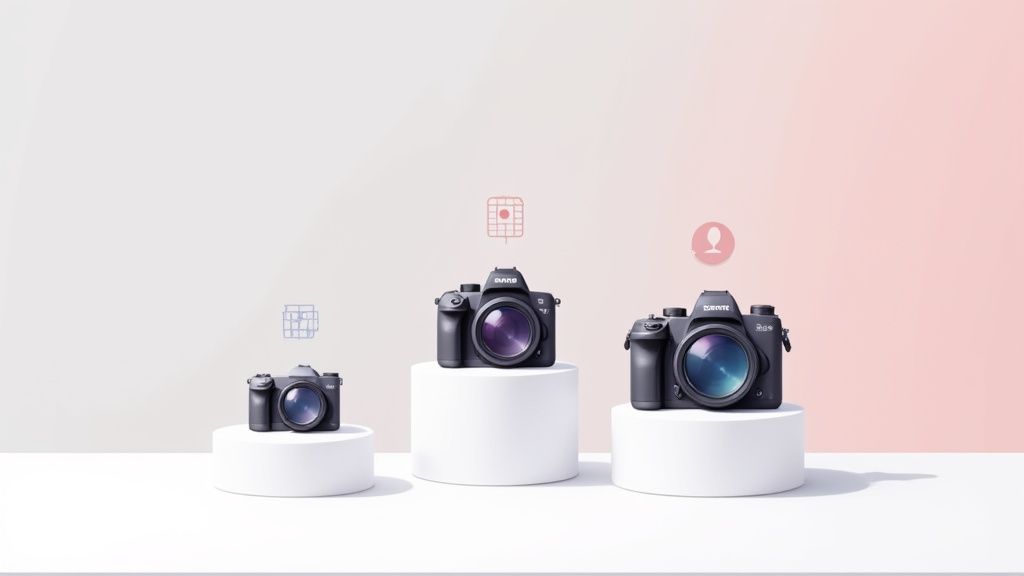The right camera for product photography isn't just about the brand name on the body; it's about a specific blend of high resolution, true-to-life color reproduction, and rock-solid performance that captures your products exactly as they are. While the pros might gravitate toward heavy-hitters like the Canon EOS R5 or Sony A7 IV, you can get stunning results with a more accessible APS-C mirrorless camera. At the end of the day, the right features always trump a high price tag.
Why Your Camera Choice Drives E-commerce Success
In the world of online shopping, your photos are your sales team. They're the very first interaction a potential customer has with what you're selling, and the quality of that first "hello" directly shapes their trust, their decision to buy, and even whether they'll return the item later. A blurry, poorly lit photo screams unprofessionalism, while a sharp, detailed image builds instant confidence. The camera you use is the cornerstone of this crucial visual handshake.
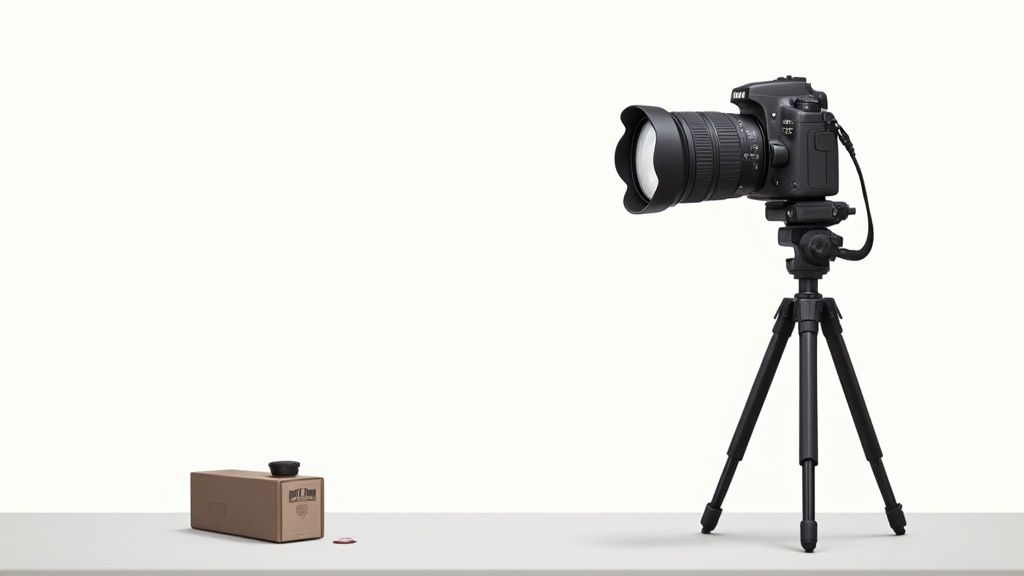
This isn't just a hunch; the market data backs it up. The global eCommerce product photography market is on track to explode from USD 0.85 billion in 2025 to roughly USD 2.38 billion by 2034. This trend shows just how much brands are leaning on incredible visuals to stop scrollers in their tracks and turn them into customers.
The Real Impact of Camera Capabilities
Picking a camera is about so much more than just counting megapixels. You're choosing a tool that needs to help you create consistently amazing images, day in and day out, without slowing you down. Certain features have a direct, tangible effect on your business.
- Color Accuracy: A camera that gets colors right means the product showing up on a customer's doorstep looks exactly like the one they saw online. This simple thing drastically cuts down on returns and complaints about color mismatch.
- Detail and Resolution: High-resolution sensors are non-negotiable. They give shoppers the power to zoom in and inspect every stitch, texture, and detail, which is make-or-break for products like fine jewelry or premium apparel. We dive deeper into this for marketplace sellers in our guide to professional Amazon product photography.
- Workflow Efficiency: Time is money, especially during a shoot. Features like tethering—where you connect your camera directly to a computer—and a reliable autofocus system can save you hours of frustration, letting you see shots on a big screen in real-time and ensuring every image is perfectly sharp.
Your camera isn't just a piece of gear; it's a strategic investment in your brand's future. It directly influences your ability to boost sales and implement advanced strategies to improve e-commerce sales. It's the difference between a product listing that gets ignored and one that makes a customer stop and say, "I need that."
Decoding the Tech Specs for Product Photography
Let's be honest, camera spec sheets can feel like they're written in another language. Manufacturers love to brag about dozens of features, but when you're shooting products in a controlled studio, only a handful of those specs truly matter. Getting a grip on these core features helps you cut through the marketing noise and focus on what will actually improve your photos and make your life easier.
Instead of getting bogged down in every last technical detail, we're going to zero in on the specs that give you the most bang for your buck in a product photography setup. These are the things that provide precise control, deliver consistent results, and give you the flexibility to create killer visuals for your brand.
Sensor Size: The Foundation of Image Quality
Think of the sensor as your camera's digital canvas—its size has a massive impact on your final image. For product photography, the conversation almost always comes down to two main players: Full-Frame and APS-C.
A full-frame sensor is physically larger, which means it can gather more light. This is a huge advantage, as it generally leads to cleaner images with less digital noise, especially if your lighting isn't perfect. That larger size also gives you much more control over depth of field, making it easier to nail that creamy, blurred background (or bokeh) that makes a product pop.
APS-C sensors are a bit smaller and are what you'll find in most budget-friendly cameras. Don't let the size fool you; they can produce absolutely fantastic images, especially with good lighting. The main trade-off is that they offer less control over that super-shallow depth of field. For most online stores, though, an APS-C camera is more than capable of getting the job done beautifully.
The Bottom Line: Go for a full-frame camera if you need maximum creative control over depth of field or often shoot in less-than-ideal light. Choose an APS-C model for a wallet-friendly option that still delivers stellar quality for standard e-commerce shots.
Resolution: It's Not Just About the Megapixels
Everyone loves to talk about megapixels, but chasing the highest number is a rookie mistake. For product photography, a resolution between 24 to 30 megapixels is the absolute sweet spot for most e-commerce businesses.
This range gives you two critical advantages:
- Incredible Detail: It’s more than enough resolution to capture the fine weave of a fabric, the intricate facets of a piece of jewelry, or the unique texture of a handmade product. This is what lets your customers zoom in and really inspect the quality.
- Cropping Power: A higher megapixel count is like having built-in insurance. It lets you crop your images heavily to create different compositions—for social media, website banners, or marketplace listings—all from a single photo, without sacrificing sharpness.
Sure, those 45+ megapixel cameras sound amazing, but they also create gigantic files that will choke your computer during editing and slow your website to a crawl. Unless you're printing your product photos on a billboard, sticking to the 24-30MP range is the smart, practical choice.
Workflow Features That Make or Break Your Shoot
The best camera isn't just about the final image; it’s also about how easily you can get there. For a smooth, professional product photography workflow, these three features are non-negotiable.
- Tethering: This is a game-changer. Tethering lets you connect your camera to a computer so your photos pop up on a big screen the instant you take them. You can check focus, lighting, and composition in real-time without squinting at a tiny screen on the back of the camera.
- Live View: A sharp, bright LCD screen with a good Live View function lets you compose your shot with absolute precision. It's perfect for making those tiny, meticulous adjustments to product placement without ever having to look through the viewfinder.
- Solid Manual Controls: Consistency is everything in product photography. You need a camera with easy-to-reach dials and buttons for aperture, shutter speed, and ISO. This ensures you can lock in your settings and perfectly replicate the look for every single product in a collection, creating a cohesive, professional feel across your entire store.
Mirrorless vs. DSLR for Modern Product Shoots
The age-old debate of mirrorless versus DSLR gets a whole new spin when you bring it inside a controlled product photography studio. While both types of cameras are more than capable of producing stunning images, their underlying technologies create wildly different shooting experiences. Your choice here can genuinely impact your studio's workflow and efficiency.
DSLRs (Digital Single-Lens Reflex) have long been the industry workhorses. They're known for their rugged builds, marathon battery life, and that classic optical viewfinder. For anyone who's spent years behind a camera, looking directly through the lens feels natural and reliable. The catch? That optical system shows you the scene exactly as it is—not how your final photo will actually be exposed. This often leads to a cycle of test shots, checking the screen, and tweaking settings.
The Mirrorless Advantage in the Studio
This is where mirrorless cameras changed the game, offering real, tangible benefits for product photographers. By ditching the bulky mirror box, they open the door to features that streamline everything from composition to the final click.
The biggest game-changer is the electronic viewfinder (EVF). The EVF is a tiny, high-resolution screen inside the viewfinder that shows you a live digital preview of your image, complete with your current exposure, white balance, and color profile applied in real-time.
What you see is precisely what you get. This live feedback completely removes the guesswork that comes with a DSLR. You can nail your lighting and perfect your settings before you even press the shutter, a feature that can save you hours on a high-volume product shoot.
This chart helps break down how different camera setups stack up across key factors like resolution, sensor size, and price, giving you a visual guide to the trade-offs.
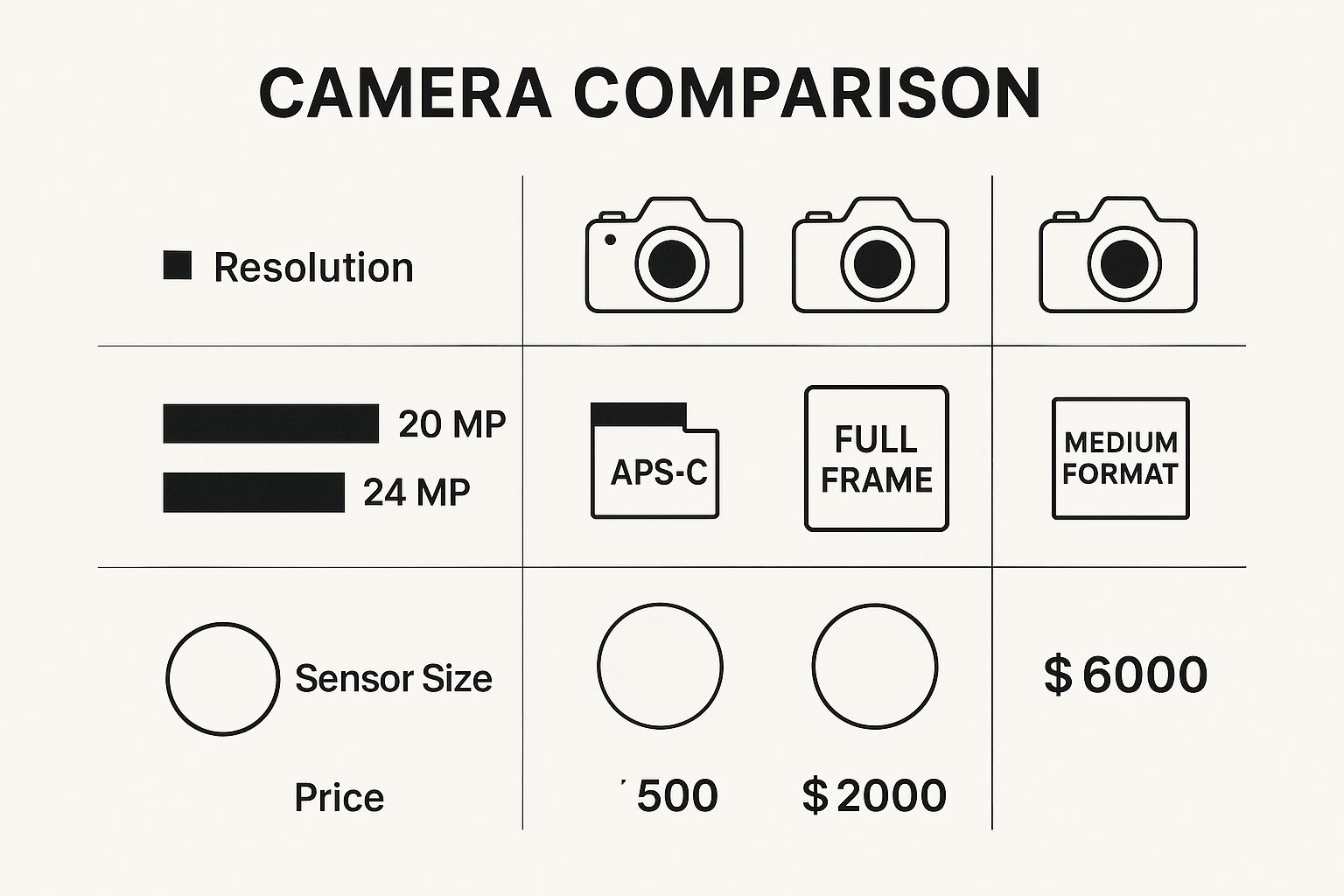
As you can see, bigger sensors and higher resolutions usually mean a bigger price tag, which helps you pinpoint where the best value lies for your specific needs.
To help you quickly compare the options, here's a table breaking down the key features for different camera tiers in product photography.
Camera Feature Comparison for Product Photography
This table compares key features of different camera types relevant to product photography to help users quickly identify the best fit for their needs and budget.
| Camera Tier | Sensor Size | Typical Resolution | Key Advantage for Products | Best For |
|---|---|---|---|---|
| Entry-Level Mirrorless | APS-C | 24-26MP | WYSIWYG electronic viewfinder, compact size. | Small businesses, e-commerce startups. |
| Pro APS-C / MFT | APS-C or Micro Four Thirds | 26-40MP | Advanced autofocus, faster performance, great lens selection. | High-volume studios, detailed product work. |
| Pro Full-Frame Mirrorless | Full-Frame | 24-61MP+ | Maximum image quality, low noise, best dynamic range. | High-end commercial, advertising, large prints. |
| Pro DSLR | Full-Frame or APS-C | 24-50MP | Excellent battery life, vast legacy lens ecosystem. | Photographers who prefer an optical viewfinder. |
This table shows a clear path: as your image quality needs increase, especially for large prints or detailed commercial work, moving to a full-frame system becomes the logical next step.
Key Features for Workflow Efficiency
Beyond the EVF, mirrorless cameras pack in other powerful tools that feel tailor-made for the studio.
- Advanced Autofocus: Many modern mirrorless cameras have incredible autofocus systems with eye-tracking and subject detection, ensuring every last detail on your product is tack-sharp.
- Silent Shutter: The electronic shutter option means you can shoot in complete silence. It’s a small luxury, but in a quiet studio, it's a welcome one—especially when shooting reflective items where even tiny vibrations can be an issue.
- Compact Form Factor: While size isn't always the top priority for studio work, a smaller and lighter body can be much easier to mount and position on a tripod, particularly for tricky overhead or complex angled shots.
The market has already voted with its wallet. In 2023, mirrorless cameras accounted for about 69% of all digital interchangeable-lens camera sales. Industry giants like Canon, which holds a commanding 46.5% of the market share, are now pouring all their energy into their mirrorless lines. The trend is crystal clear. You can discover more insights about the digital camera market trends and see how it’s shaping the tools we use.
Top Camera Picks for Every Budget and Business
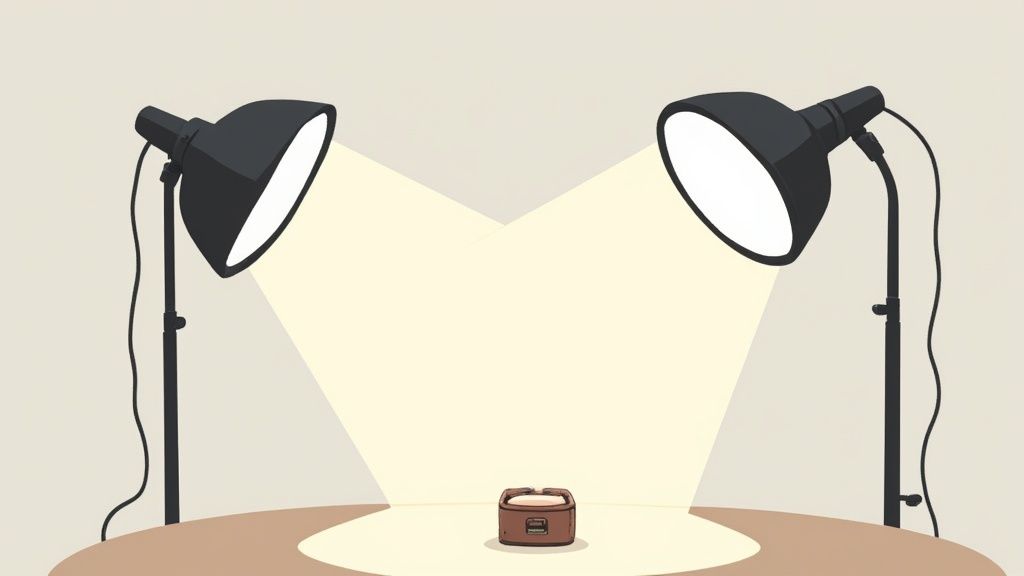
Jumping into the camera market can feel like navigating a minefield of specs and confusing model numbers. But here’s the secret: the best camera for product photography is simply the one that fits your business needs and doesn’t drain your bank account.
Instead of just rattling off a list of cameras, I've broken down my top picks into practical tiers that make sense for different stages of business. This way, you can see exactly how a certain feature translates into real-world benefits for your online store—whether it's a camera’s color science saving you hours in post-production or its resolution being perfect for those detailed zoom features on Amazon and Shopify.
Let's find the right tool for your workflow, whether you're just getting started or ready to scale.
Best for Startups and Small Businesses
When you're launching a new venture or running a small e-commerce shop, every dollar and every minute counts. You need a camera that produces professional-looking shots without a massive learning curve or a hefty price tag. For this, modern APS-C mirrorless cameras are the undisputed champions.
Top Pick: Sony A6400
The Sony A6400 is an absolute powerhouse for the price and my go-to recommendation for anyone starting out. Its 24.2MP APS-C sensor delivers more than enough detail for stunning web images, and its autofocus system is legendary for a reason—it makes sure your products are tack-sharp, every single time.
- Real-World Benefit: Sony’s Real-time Eye AF and Tracking is a game-changer. It locks onto your subject with unbelievable precision, which means fewer blurry, unusable shots and a whole lot less frustration.
- Workflow Integration: It’s small and has a tilting screen, making it a breeze to set up for those tricky overhead flat-lay shots that are so crucial for product arrangements.
Sure, it doesn’t have in-body image stabilization (IBIS), but for product photography, you’re almost always using a tripod anyway, making it a non-issue. The A6400 is a true workhorse that proves you don’t need to spend a fortune to create images that sell. If you're just starting, understanding the full https://prodshot.net/cost-of-professional-product-photography can help you see where a smart camera purchase fits into the bigger picture.
The Professional E-commerce Workhorse
As your business grows, your photography needs to grow with it. You're probably shooting more products, need dead-on consistency across your catalog, and want more flexibility to crop for different platforms. It’s time to step up to a full-frame system for its superior image quality and more robust features.
Top Pick: Canon EOS R6 Mark II
The Canon EOS R6 Mark II hits the sweet spot between performance, resolution, and price for a serious e-commerce operation. Its 24.2MP full-frame sensor is fantastic in various lighting conditions and, most importantly, delivers beautiful colors right out of the camera—a signature of Canon's famous color science.
Canon’s color reproduction is often praised for its pleasing, true-to-life vibrancy. For fashion or beauty brands, this is huge. It means getting your product’s shade right with far less time spent tweaking colors in post-production.
The in-body stabilization is a nice bonus for any handheld work, and the interface is incredibly intuitive, which helps you move fast during a busy shoot. This camera is a reliable tool built to handle the daily grind of a productive studio.
Ultimate Quality for High-End Brands
For luxury brands, ad agencies, or any business that needs flawless images for large-format prints, image quality is everything. At this level, you need a camera that captures every single texture and detail, giving you maximum freedom for retouching, cropping, and creating those big, impactful marketing visuals.
Top Pick: Sony A7 IV
The Sony A7 IV is a resolution monster and a firm favorite among commercial photographers. Its 33MP full-frame sensor captures an astonishing amount of detail, allowing you to create images that stay razor-sharp even after heavy cropping or when blown up for a billboard.
- Key Advantage: That high megapixel count is perfect for showing off intricate details in products like jewelry, high-end electronics, or luxury fabrics.
- Performance Edge: When you pair that resolution with Sony's top-tier autofocus, you can be confident that the most critical part of your product is perfectly in focus in every single shot.
While its menu system can feel a bit dense at first, the raw image quality and dynamic range of the A7 IV are unmatched in its class. It delivers the technical muscle you need to create the kind of aspirational imagery that reflects a premium brand’s value.
Beyond the Camera: Building Your Photo Toolkit
Choosing the right camera is a great start, but it's only one piece of the puzzle. To create images that truly pop off the screen and drive sales, you need to think about the entire toolkit. The real magic happens when you pair your camera with the right lenses and, most importantly, the right lighting.
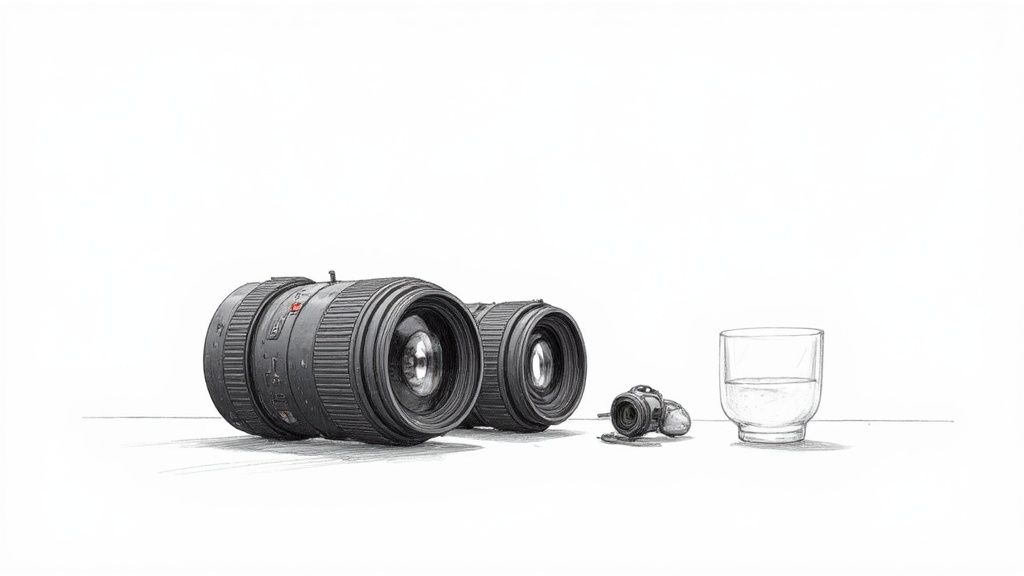
This isn't just about buying gear; it's a direct investment in your business. The demand for incredible visuals is exploding, with the photographic services market valued at USD 37.96 billion in 2025 and projected to hit a massive USD 64.68 billion by 2034. That growth is fueled by e-commerce, where your photos are your storefront. You can dig into more of these market insights over on Precedence Research.
Selecting the Right Lens for the Job
Your lens choice dramatically changes how your product looks to a potential customer. The wrong one can introduce weird distortions, making things look warped or just plain unprofessional.
-
Macro Lenses: If you’re shooting small, detailed items like jewelry, watches, or cosmetics, a macro lens is absolutely essential. It lets you get impossibly close to capture every intricate detail with perfect, edge-to-edge sharpness.
-
Standard Prime Lenses: For most other products—think apparel, accessories, or electronics—a prime lens with a focal length between 50mm and 85mm is your workhorse. These lenses capture a natural perspective without any noticeable distortion, ensuring your products look exactly how they should. A good prime lens will always deliver sharper results than the basic zoom lens that came with your camera.
Demystifying Studio Lighting
Here's the secret ingredient: great lighting. Natural light can be beautiful, but it's wildly inconsistent. A controlled studio lighting setup gives you the power to make every single photo in your catalog look uniform and professional.
For beginners, a simple two-light setup is all you really need. You'll have a main key light to provide the primary illumination and a second fill light to soften any harsh shadows.
Key Insight: Consistent lighting is way more important than an expensive camera. I've seen it a thousand times: a budget-friendly camera with a great lighting setup will produce better results than a high-end camera with bad lighting. Every single time.
When it comes to picking lights, you've got two main options:
- Continuous LED Lights: These lights stay on, so you can see exactly how the light is hitting your product in real-time. It's a "what you see is what you get" approach, which makes them incredibly easy to learn for beginners.
- Strobes (Flashes): Strobes deliver a powerful pop of light the instant you press the shutter. They offer way more power than LEDs, which allows you to use camera settings that create exceptionally sharp images. They have a slight learning curve, but they're the standard in professional studios for a reason.
Building out your toolkit with the right lenses and lighting is a game-changer. And once you've captured those perfect shots, our guide to photo editing services for ecommerce can help you add the final polish.
Answering Your Product Photography Camera Questions
Even after weighing all the options, a few key questions always seem to pop up before pulling the trigger on a new camera. It's completely normal.
To help you feel 100% confident in your choice, I’ve put together some straightforward answers to the most common questions I hear. We'll cut through the noise on sensor sizes, megapixels, and even using your phone, so you can invest in the right gear for your business.
Do I Need a Full-Frame Camera for Product Photography?
Honestly? Not necessarily. Full-frame cameras are incredible, no doubt, especially for their image quality and creamy background blur. But they're absolutely not a requirement for killer e-commerce photos.
A modern APS-C camera has more than enough power to produce stunning, high-resolution images perfect for any online store, including giants like Amazon and Shopify. For product shots, things like your lighting setup, a sharp lens, and getting your colors right will make a much bigger difference than sensor size alone. An APS-C body is a smart, budget-friendly choice for most sellers.
In a controlled studio environment, the advantages of a full-frame sensor shrink. A great lens and solid lighting on an APS-C camera will beat a full-frame setup with a poor lens and bad light every single time.
How Many Megapixels Do I Really Need?
This is a big one. For almost all online product photography, the sweet spot is between 24 and 30 megapixels. This gives you more than enough detail for customers to zoom in and see textures without creating massive, computer-choking files.
This range also gives you a ton of cropping flexibility. You can take one great shot and easily reframe it for a website banner, an Instagram post, or a marketplace thumbnail without losing any sharpness. Cameras with 45MP or more are amazing for massive prints, but for standard web use, they're often overkill and can really slow down your workflow.
Can I Use My Smartphone for Professional Shots?
For a brand-new business just getting its feet wet or for banging out quick social media content, a high-end smartphone can do a surprisingly good job. But you need to pair it with excellent lighting and a tripod.
That said, for building a professional, consistent product catalog, a dedicated camera with interchangeable lenses is in another league. It gives you far more creative control.
Here are the key advantages:
- Manual Control: You can lock in your aperture, shutter speed, and ISO to get perfectly consistent lighting and focus across every single product.
- Superior Optics: The ability to swap on a specialized macro lens for jewelry or a tilt-shift for architecture is a total game-changer.
- Tethering Capability: Hooking your camera up to a computer for a live preview on a big screen streamlines your process and helps you catch mistakes instantly.
So while a smartphone is a decent place to start, a dedicated camera is the clear winner for creating the kind of high-quality, trustworthy images that drive sales in a crowded online market.
Ready to create stunning, sales-driving visuals without the complex gear? ProdShot uses AI to transform simple smartphone photos into professional-grade product images in seconds. Try it for free and see how easy it is to elevate your brand.

